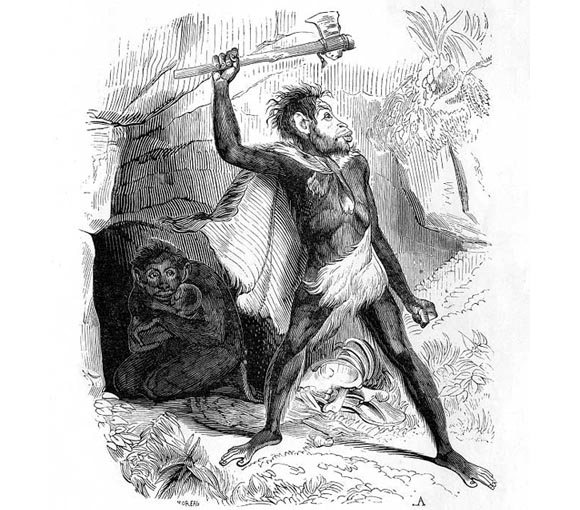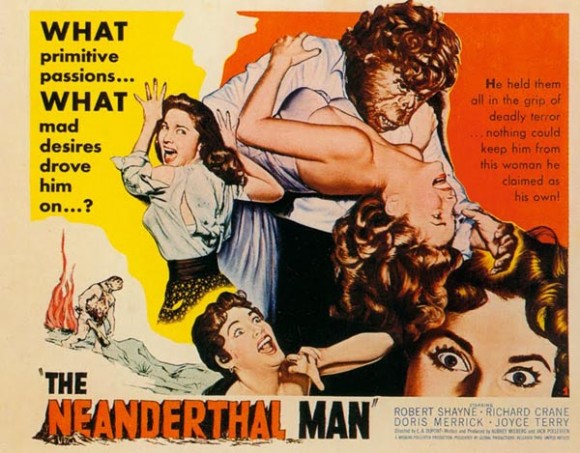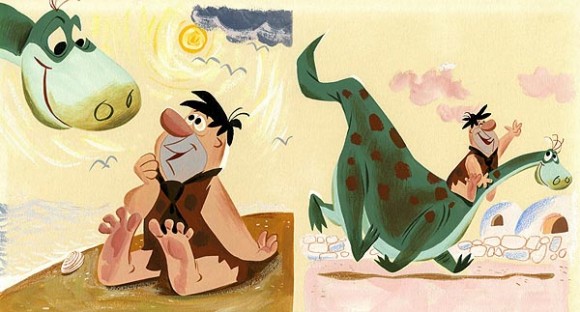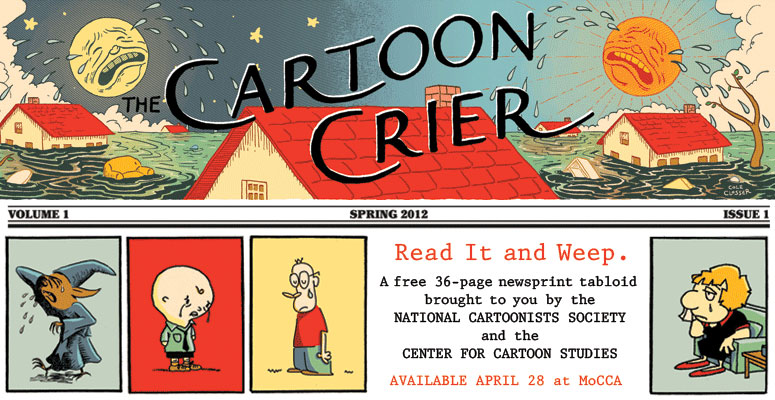
We can’t seem to get over our obsession with the caveman, who has appeared on screen since at least 1912. In fact, anthropologist Judith Berman has written that a new caveman character has been introduced into pop culture every year since World War II.
DreamWorks’ The Croods, directed by Chris Sanders and Kirk De Micco, presents the most recent version of prehistoric man; Grug, is a responsible father facing such dad-like issues as a teenage daughter who just wants to be her own person. He transcends the behavior expected of a typical caveman, but his character design doesn’t evolve past a stereotype that is largely of our own making.
We’ve distilled an entire subspecies of human down to a single iconic image, one that is perpetuated year after year through film, animation, comic art and bad Halloween costumes. The caveman is always brutish, dressed in some type of fur loin cloth and possessing limited intelligence. Some stereotypes of prehistoric humans are certainly based on archeological facts: the structure of the skull, anatomical proportions and pelt-based wardrobe. But other stereotypes, such as wielding clubs, communing with dinosaurs and pulling women by the hair, are our own projections of prehistoric behavior.

The iconic caveman image we know today was already established by the 1930s, seen in the comic strip Alley Oop. He carried a stone axe, manhandled women and rode a dinosaur named Dinny. Alley Oop, along with the Fleischer’s Stone Age Cartoons series, was a response to western society grappling with what it meant to be modern. The simple world of the caveman was a nostalgic comfort to those who feared progress.

Alley Oop was the pop culture bookend of a caveman fiction trend that began in the 19th century. One of the earliest examples is Paris Before Man, a novel written by Pierre Boitard in 1861. The frontispiece print (above) shows a club-wielding caveman, protecting his mate. As the genre developed, the caveman became more brutish and ill-mannered—an 1886 short story written by Andrew Lang describes a marriage custom in which women are “knocked on the head and dragged home.” By the 1920s, numerous newspaper headlines used “caveman” and “neanderthal” as adjectives to describe senseless male brutality.

The mid-century resurgence of cavemen in film (The Neanderthal Man, Monster on Campus), comics (B.C.) and television (The Flintstones) can partly be blamed on World War II rhetoric. Newscasters sang the praises of atomic power while warning of its devastating potential to send us back to a new Stone Age. To help us deal with these fears, the caveman was domesticated; The Flintstones showed that, even as the worst case scenario, the Stone Age wasn’t so bad. Even cavemen could wear neckties and accomplish an honest day’s work.

Over time, films and TV shows have moved away from the wife-clubbing caveman of the 19th century to fit G-rated expectations of civilized society. In fact, The Croods has pushed the caveman to the opposite end of the spectrum, with a father figure that seems like he could handle modern-day discussions of co-parenting and all-terrain strollers. No longer a commentary on uncivilized man or our fears of the future, the caveman and his era presented in The Croods is merely a backdrop ideal for contrasting our modern reality of iPods and WiFi.
BY JEN VAUGHN – Read it and weep! Go have yourself a good cry (probably at a Disney movie). In the tradition of occasionally free newsprint tabloid comics like the one-shot Caboose and quarterly Smoke Signal, a collaborative comic will be available this weekend at MoCCA! Official press release below:

The word “comic” has always been a bit of misnomer and The Cartoon Crier hopes to set the record straight. Sorrow and woe is the focus of this free 36-page newspaper tabloid that highlights the work of members of The National Cartoonists Society and of The Center for Cartoon Studies’ community.
The Cartoon Crier will premiere on Saturday, April 28 at The Museum of Comic and Cartoon Art Festival (MoCCA) in New York City.
The Cartoon Crier features the saddest strips from iconic comics like Family Circus, Beetle Bailey, Dennis the Menace, B.C., and For Better and For Worse. The Cartoon Crier also includes comics by Ivan Brunetti, Mell Lazarus, Melissa Mendes, Joe Lambert, Tom Gammill, Hilary Price, Laura Park, Richard Thompson, and Mo Willems as well as new work from the paper’s editors Cole Closser, R. Sikoryak, and James Sturm.
The Cartoon Crier will be available as a free download on May 1 from cartoonstudies.org.
—
Jen Vaughn is ready to weep tears in four colors: CMYK.
 I first noticed it when I was a kid. Growing up a fan of the comic page, my family owned some bound book collections of comics like Doonesbury and Garfield and B.C. I rather liked the old B.C. comics by Johnny Hart, actually. In spite of the fact that characters had names like The Fat Broad and The Cute Chick, there was the ever amusing Grog (a Neanderthal in a caveman’s world) and The Apteryx, who always introduced himself as “a wingless bird with hairy feathers”.
I first noticed it when I was a kid. Growing up a fan of the comic page, my family owned some bound book collections of comics like Doonesbury and Garfield and B.C. I rather liked the old B.C. comics by Johnny Hart, actually. In spite of the fact that characters had names like The Fat Broad and The Cute Chick, there was the ever amusing Grog (a Neanderthal in a caveman’s world) and The Apteryx, who always introduced himself as “a wingless bird with hairy feathers”.
But starting around 1984 the strip I saw in my newspaper started to change. The comic that I’d always loved started to get strangely religious. Hart, it seems, had experienced a religious conversion or renewal of some sort and suddenly it was all about the God.
I hadn’t thought much about old B.C. until the other day when I noticed that as series go, B.C. (which Matt has pointed out is ironically the ONLY comic strip to specifically say that the actions in the storyline happen “Before Christ”) is not alone. Periodically there are characters and series that kids love that one day suddenly become evangelical. Sometimes as a separate series. Sometimes as part of the whole. B.C., it seems, was just part of a trend.
Now I totally understand and am fine with a series being Christian. My focus here is more on those characters that establish themselves as beloved and secular and then suddenly pull a religious conversion on their readers without much warning. I find this whole idea fascinating. How many characters have engaged in such a switch? Two immediate examples come to mind.
Meet Christian Archie
 Archie comics rock. This is proven by any cursory trip to ComicCon. Find the Archie section of the conference floor and you’ll be immediately amazed by the hoards of Archie fans, young and old, that congregate there. At some point in the 21st century Archie was allowed to be cool.
Archie comics rock. This is proven by any cursory trip to ComicCon. Find the Archie section of the conference floor and you’ll be immediately amazed by the hoards of Archie fans, young and old, that congregate there. At some point in the 21st century Archie was allowed to be cool.
However, there was an interesting moment in time when Archie and friends got super Christian, super fast. Back in the mid-1970s Archie comics staffer Al Hartley managed to do what today would be impossible. He convinced his boss John Goldwater to negotiate a deal with Spire Christian Comics. Spire would get to use the licensed Archie characters for specifically Christian comic books and the Archie name would get a leg up in the whole family friendly section of the world. So eighteen such Archie comics were created.
Vanity Fair covered Archie back in 2006 and discussed this phenomenon. The comics were never intended to circulate in the secular market, but somehow they did. For a full history of the comics themselves you can read Kliph Nesteroff’s A History of Christian Archie Comics, which gives a thorough rundown of what happened. Comics Alliance also worked up











I’ve got work in there too.
This looks like a must-have! I will weep if I don’t land a copy.
WANT
There is a TON of great work in there: James Kochalka, Lynn Johnston, Mort Walker, Dean Young as well as more from the CCS crowd like Donna Almendrala, Dakota McFadzean, Katherine Roy and MORE.
Part of the fun is NOT mentioning all names.
Wow… about time the NCS started attending some comic cons!
Sounds like a good idea for a blog… “Crying in the comics”.
Hmm… did anyone ever cry in Peanuts? Or was it all “AAUGH!” and plewds?
That looks great!